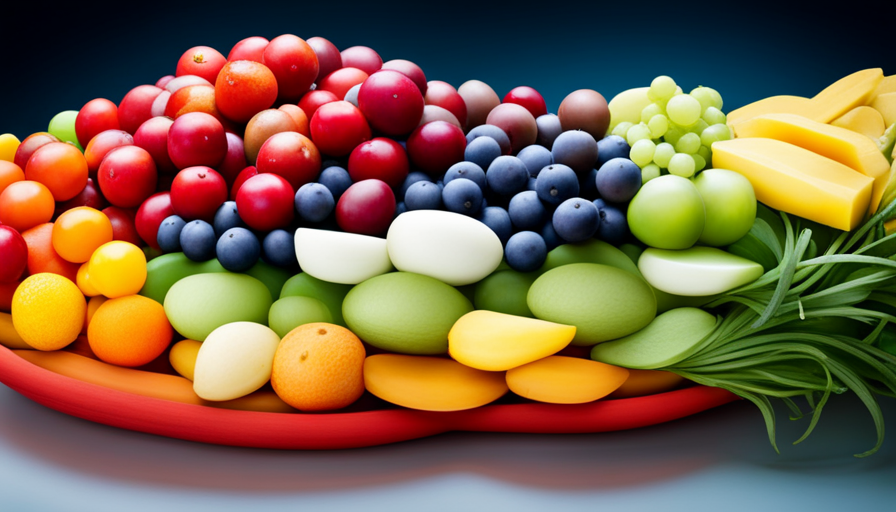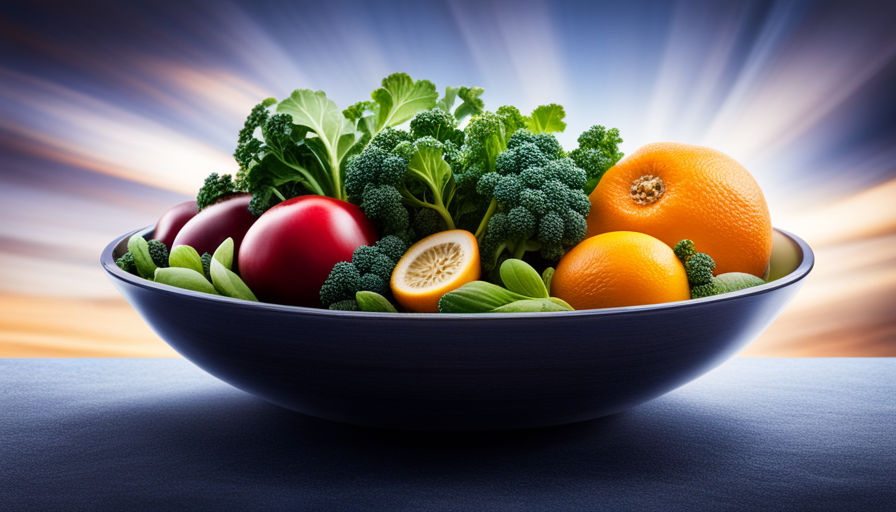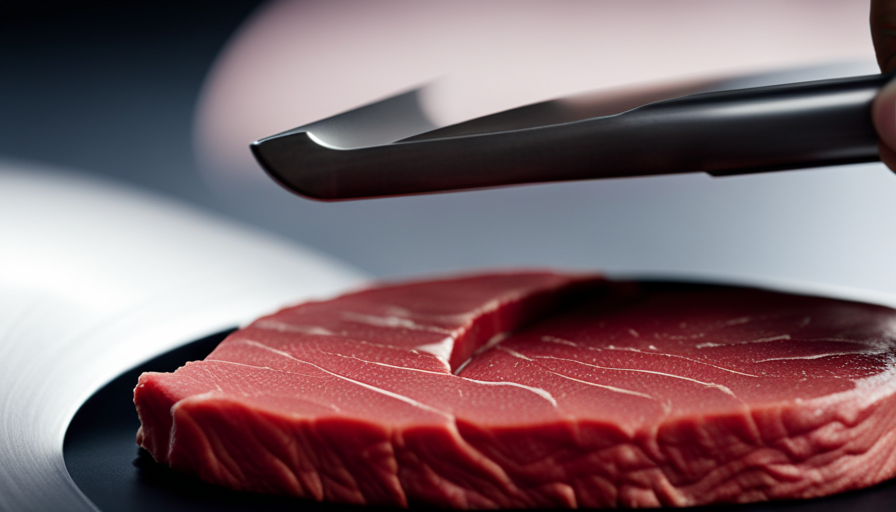Your diet influences your identity, and for individuals looking to improve their health and wellness, transitioning to a raw food diet could be a pivotal move. As the saying goes, ‘Food is thy medicine.’
A raw food diet is centered around consuming unprocessed, uncooked, and organic foods, providing your body with a plethora of essential nutrients and enzymes. This lifestyle choice has gained popularity for its potential to boost energy levels, promote weight loss, improve digestion, and enhance overall vitality.
But embarking on a raw food journey can be daunting without proper guidance. In this article, we will delve into the principles of a raw food diet, share tips for transitioning to this lifestyle, and explore delicious recipes and preparation techniques.
Get ready to embrace the benefits of a raw food lifestyle and take charge of your health like never before.
Key Takeaways
- Transition to a raw food diet gradually
- Incorporate a variety of raw fruits, vegetables, nuts, seeds, and grains into meals
- Consult a healthcare professional or registered dietitian for guidance
- Ensure proper nutrition by meal planning and considering fortified plant-based products or supplements
Understanding the Principles of a Raw Food Diet
If you’re ready to transform your health and boost your energy levels, it’s time to dive into the principles of a raw food diet! Understanding the benefits and getting started tips will set you on the path to success.
One of the main benefits of a raw food diet is the abundance of nutrients it provides. Raw fruits, vegetables, nuts, and seeds are rich in vitamins, minerals, and enzymes that can enhance your overall well-being. By consuming these foods in their natural state, you maximize their nutritional value and reap the benefits of a vibrant and energized body.
To get started on a raw food diet, begin by incorporating more raw foods into your meals. Start by including a raw salad or a piece of fresh fruit with each meal. Gradually increase the amount of raw food you consume until it becomes the main component of your diet. Experiment with different recipes and techniques to keep your meals exciting and enjoyable.
It’s important to remember that a raw food diet may not be suitable for everyone. If you have any underlying health conditions or concerns, it’s best to consult with a healthcare professional before making any drastic changes to your diet.
By understanding the principles of a raw food diet and following these getting started tips, you’ll be well on your way to reaping the benefits of this health-conscious lifestyle.
Transitioning to a Raw Food Lifestyle
When embarking on a raw food journey, it’s like diving into a vibrant garden of nourishment and vitality. Transitioning to a raw food lifestyle can be both exciting and challenging.
Here are some tips to help you make a smooth transition and find the support you need:
-
Start gradually: Instead of diving headfirst into a 100% raw food diet, start by incorporating more raw fruits, vegetables, nuts, and seeds into your meals. This gradual approach allows your body to adjust and prevents any sudden shock to your system.
-
Experiment with recipes: Explore the world of raw food recipes to keep your meals interesting and flavorful. From raw salads and veggie wraps to smoothies and raw desserts, there are countless delicious options to choose from.
-
Find support: Transitioning to a raw food lifestyle can be easier when you have support from like-minded individuals. Seek out online communities, join local raw food meetups, or find a raw food buddy who can share recipes, tips, and encouragement along the way.
Remember, transitioning to a raw food lifestyle is a personal journey, and it’s important to listen to your body’s needs. Consulting with a healthcare professional or a registered dietitian can also provide you with personalized guidance and ensure you’re meeting your nutritional needs.
Incorporating Raw Fruits and Vegetables into Your Meals
Embrace the vibrant colors and flavors of nature by incorporating the freshness of raw fruits and vegetables into your daily meals. Meal planning is key when transitioning to a raw food diet. By planning your meals in advance, you ensure that you have a variety of fruits and vegetables on hand to create delicious and nutritious dishes. Start by making a list of your favorite raw fruits and vegetables and brainstorm different ways to incorporate them into your meals.
One way to incorporate raw fruits and vegetables into your meals is by creating colorful salads. Mix together a variety of leafy greens, such as spinach, kale, and arugula, and top it with a variety of raw veggies like bell peppers, cucumbers, and cherry tomatoes. You can also add some fruits like strawberries or oranges to add a touch of sweetness to your salad.
Another way to incorporate raw fruits and vegetables is by making raw food snacks. Cut up some fresh fruits like apples, pears, and melons into bite-sized pieces and keep them in your fridge for a quick and healthy snack. You can also make vegetable sticks with carrots, celery, and bell peppers and pair them with a homemade dip like hummus or guacamole.
Meal planning and incorporating raw fruits and vegetables into your meals not only adds variety and flavor to your diet but also provides you with essential nutrients and antioxidants. So start exploring the world of raw fruits and vegetables and enjoy the benefits of a raw food lifestyle.
| Raw Fruits | Raw Vegetables |
|---|---|
| Apples | Carrots |
| Oranges | Celery |
| Strawberries | Bell peppers |
Exploring Raw Nuts, Seeds, and Grains
Discover the richness and nourishment that raw nuts, seeds, and grains can bring to your meals. Incorporating these natural and unprocessed foods into your raw food diet can provide numerous benefits for your health and help with weight loss.
Here are four reasons why you should include raw nuts, seeds, and grains in your meals:
-
Raw nuts, such as almonds, walnuts, and cashews, are packed with essential nutrients like healthy fats, protein, fiber, vitamins, and minerals. They can help lower cholesterol levels, reduce the risk of heart disease, and support brain health.
-
Seeds like chia, flax, and pumpkin seeds are excellent sources of omega-3 fatty acids, fiber, and antioxidants. They can improve digestion, regulate blood sugar levels, and promote healthy skin.
-
Whole grains like quinoa, buckwheat, and amaranth are rich in fiber, vitamins, and minerals. They can provide sustained energy, improve digestion, and support weight loss.
-
Including these raw nuts, seeds, and grains in your meals can add texture, crunch, and depth of flavor to your dishes, making your raw food diet more enjoyable and satisfying.
By incorporating raw nuts, seeds, and grains into your meals, you can enhance the nutritional value of your raw food diet and experience the benefits they offer for weight loss and overall health.
Creating Delicious Raw Food Recipes
Incorporating raw nuts, seeds, and grains into your meals allows you to unleash your culinary creativity and create delectable recipes that nourish your body and tantalize your taste buds.
When it comes to raw food desserts, the possibilities are endless. Raw desserts are made without cooking or baking, which helps to preserve the natural enzymes and nutrients present in the ingredients. You can make delicious treats like raw chocolate avocado mousse, raw fruit tarts, or raw coconut macaroons. These desserts are not only satisfyingly sweet but also packed with vitamins, minerals, and fiber.
Raw food smoothies are another fantastic way to enjoy the benefits of a raw food diet. You can blend together a variety of raw fruits, vegetables, and even nuts or seeds to create a refreshing and nutritious beverage. Try a green smoothie with spinach, kale, banana, and almond milk for a quick and energizing breakfast or snack. Or, indulge in a tropical smoothie with mango, pineapple, coconut water, and chia seeds for a taste of paradise. The possibilities for raw food smoothies are endless, and they are a great way to incorporate more raw fruits and vegetables into your diet.
By exploring raw food desserts and smoothies, you can add a touch of sweetness and creativity to your raw food diet. Enjoy experimenting with different flavors and ingredients, and discover the delicious world of raw food cuisine.
Ensuring Proper Nutrition on a Raw Food Diet
Now that you have learned how to create delicious raw food recipes, it’s important to ensure that your raw food diet is providing you with proper nutrition. Proper hydration is key when following a raw food diet, as many raw fruits and vegetables have high water content that can help keep you hydrated. Be sure to drink plenty of water throughout the day, and consider incorporating hydrating foods such as cucumbers and watermelon into your meals.
While a raw food diet can be rich in vitamins and minerals, it is important to be aware of potential nutrient deficiencies. Some nutrients, such as vitamin B12 and omega-3 fatty acids, are more commonly found in animal-based foods. To ensure you are getting all the necessary nutrients, it may be beneficial to include fortified plant-based products or supplements in your diet. Additionally, it is important to vary your food choices and include a wide range of fruits, vegetables, nuts, and seeds to ensure you are getting a diverse array of nutrients.
To help you plan your meals and ensure proper nutrition on a raw food diet, here is a table that provides examples of nutrient-rich raw foods and the key nutrients they contain:
| Nutrient | Examples of Nutrient-Rich Raw Foods |
|---|---|
| Vitamin C | Oranges, strawberries, bell peppers |
| Vitamin A | Carrots, sweet potatoes, kale |
| Iron | Spinach, lentils, pumpkin seeds |
| Calcium | Broccoli, almonds, sesame seeds |
| Omega-3 fatty acids | Flaxseeds, chia seeds, walnuts |
By incorporating a variety of these nutrient-rich foods into your raw food diet and ensuring proper hydration, you can enjoy the benefits of a raw food lifestyle while meeting your nutritional needs.
Overcoming Challenges and Staying Motivated
To stay motivated and overcome challenges, it’s important to remember that a raw food lifestyle offers a wide range of delicious and nutrient-rich options. By focusing on the positive aspects of this diet, you can stay motivated and committed to your health goals.
Here are some tips to help you stay motivated and overcome obstacles on your raw food journey:
-
Find a support system: Surround yourself with like-minded individuals who can offer encouragement and share their own experiences. Join online communities, attend raw food events, or find a local support group.
-
Set realistic goals: Start small and gradually increase the amount of raw food in your diet. Setting achievable goals will give you a sense of accomplishment and keep you motivated.
-
Sub-list 1: Focus on the benefits of a raw food diet:
- Increased energy levels
- Clearer skin
- Weight loss
-
Sub-list 2: Celebrate your progress:
- Keep a food journal to track your success
- Reward yourself with non-food treats, like a massage or a new workout outfit
Remember, staying motivated and overcoming obstacles is a journey. Be kind to yourself, stay focused on your goals, and enjoy the delicious and nutritious foods that a raw food diet has to offer.
Incorporating Raw Superfoods into Your Diet
You can easily boost your health and well-being by adding nutrient-rich raw superfoods to your daily meals. One such superfood is chia seeds, which contain an impressive 5 grams of fiber per tablespoon. This high fiber content can aid in digestion and help you feel fuller for longer, making it a great addition to your raw food diet.
Incorporating raw superfoods into your diet doesn’t have to be complicated. One delicious way to enjoy them is by making raw food desserts. You can create mouthwatering treats like raw chocolate mousse made with avocado and cacao powder or raw fruit tarts using a nut and date crust. These desserts not only satisfy your sweet tooth but also provide you with the nutritional benefits of the raw superfoods they contain.
When it comes to snacks, raw superfoods offer a convenient and healthy option. You can snack on raw nuts and seeds, such as almonds and pumpkin seeds, which are packed with protein and healthy fats. Another great snack idea is raw vegetable sticks paired with a homemade raw hummus or a creamy avocado dip.
Incorporating raw superfoods into your diet adds variety, flavor, and a nutritional punch to your meals. So, start experimenting with raw food desserts and snacks to enhance your raw food diet and enjoy the benefits they bring to your health.
Exploring Raw Food Preparation Techniques
Exploring the world of raw cuisine opens up a whole new realm of culinary possibilities. With raw food, you can create delicious and nutritious meals using a variety of preparation techniques.
Here are some blending techniques and dehydrating methods to help you make the most of your raw food diet:
-
High-Speed Blending: Invest in a high-powered blender to make smoothies, sauces, and soups. This’ll help you achieve a creamy and smooth texture without cooking the ingredients.
-
Nut Milk Bag: Use a nut milk bag to strain your blended creations, removing any pulp or solids. This’ll give your smoothies a silky and refined consistency.
-
Spiralizing: Invest in a spiralizer to turn vegetables like zucchini and carrots into noodles. These veggie noodles can be used as a base for salads, stir-fries, or raw pasta dishes.
-
Dehydrating: Dehydrating is a technique used to remove moisture from food while preserving its nutrients. You can use a dehydrator or an oven at a low temperature to make raw crackers, granola, and even fruit leather.
By incorporating these blending techniques and dehydrating methods into your raw food diet, you can create a wide variety of delicious and nutritious meals. Experiment with different flavors and textures to discover the endless possibilities of raw cuisine.
Embracing the Benefits of a Raw Food Lifestyle
Discover the numerous advantages of embracing a lifestyle centered around the nourishing and vibrant world of raw cuisine. A raw food diet isn’t just a great way to shed unwanted pounds, but it also promotes improved digestion.
When it comes to weight loss, a raw food diet can be highly effective. Raw foods are naturally low in calories and high in fiber, which can help you feel full and satisfied while consuming fewer calories. Additionally, raw foods are packed with essential nutrients and enzymes that support a healthy metabolism and promote fat burning. By incorporating more raw fruits, vegetables, nuts, and seeds into your diet, you can achieve your weight loss goals while still enjoying delicious and nutritious meals.
Furthermore, a raw food diet can have a positive impact on digestion. Raw foods are rich in fiber, which aids in regular bowel movements and prevents constipation. Additionally, raw foods contain live enzymes that help break down food and improve nutrient absorption. This can lead to better digestion, reduced bloating, and increased energy levels.
A raw food lifestyle offers various benefits, including weight loss and improved digestion. By incorporating more raw foods into your diet, you can achieve a healthier and more vibrant life.
Frequently Asked Questions
Can I eat cooked food occasionally while on a raw food diet?
Occasionally indulging in cooked food while on a raw food diet can be tempting. However, it’s important to remember that the benefits of a raw food diet come from consuming unprocessed, nutrient-rich foods.
Interestingly, studies show that raw food enthusiasts have lower body mass index (BMI) compared to those who consume cooked foods.
If you’re craving something cooked, try alternatives like lightly steamed vegetables or sprouted grains. Remember, incorporating cooked food occasionally may still provide some health benefits.
How can I ensure I am getting enough protein on a raw food diet?
To ensure you’re getting enough protein on a raw food diet, focus on incorporating raw vegan protein sources into your meals. These can include foods like nuts, seeds, legumes, and sprouted grains. Nuts and seeds, such as almonds, chia seeds, and hemp seeds, are particularly high in protein. You can also consider adding plant-based protein powders to your smoothies or other recipes. Remember to vary your protein sources to make sure you’re getting a wide range of essential amino acids.
Are there any potential health risks associated with a raw food diet?
Are there any potential health risks associated with a raw food diet?
While a raw food diet can offer many benefits, it’s important to be aware of potential dangers.
One concern is the risk of nutrient deficiencies, as certain nutrients like protein, calcium, and vitamin B12 may be lacking in a raw food diet.
Additionally, there’s a potential for foodborne illnesses from consuming raw or undercooked foods.
It’s crucial to ensure a balanced and varied diet to minimize these risks.
Can I still eat out at restaurants while following a raw food diet?
When following a raw food diet, there are still eating out options available, although it may present some challenges. Many restaurants offer salads, vegetable dishes, and fresh fruit, which can be suitable for a raw food diet. However, it’s important to communicate your dietary preferences to the restaurant staff and ask for modifications if needed.
Additionally, be cautious of hidden ingredients and cooking methods used in certain dishes.
How long does it typically take to see results on a raw food diet?
On a raw food diet, it typically takes about 3-6 months to see noticeable results in terms of weight loss. However, this timeline can vary depending on individual factors like metabolism and exercise habits.
Common challenges of this diet include the need for meal planning and preparation, as well as potential nutrient deficiencies. It’s important to consult with a healthcare professional before starting any new diet to ensure it’s safe and suitable for your specific needs.
Can I Combine a Raw Food Diet with a Ketogenic Diet for Maximum Health Benefits?
Yes, it is possible to combine a raw food ketogenic diet for maximum health benefits. By focusing on high-fat, low-carb foods while incorporating raw fruits, vegetables, and nuts, you can achieve the benefits of both diets, including weight loss and improved energy levels.
Conclusion
Congratulations on completing this article on how to go on a raw food diet! By embracing this lifestyle, you’ve got the opportunity to enhance your health and well-being through the consumption of fresh, unprocessed foods.
While the transition may present challenges, staying motivated and exploring new recipes and preparation techniques will help you overcome them.
Remember, incorporating raw fruits, vegetables, nuts, seeds, grains, and superfoods into your diet can have numerous benefits. So, why wait? Start your raw food journey today and experience the incredible transformation it can bring to your life!

















